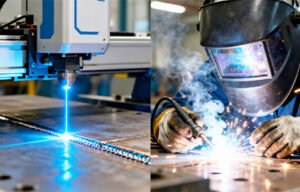Is Handheld Laser Welding Really Suitable for Small Factories?
With rapid advancements in laser technology, handheld laser welding machines have gained popularity in many manufacturing environments. For small factories in particular, selecting the right welding method can greatly impact operational efficiency, cost control, and product quality. But is handheld laser welding truly the best solution for small businesses? This article will explore that question from a customer-oriented perspective.
What Is a Handheld Laser Welding Machine?
A handheld laser welding machine is a modern welding device that uses a focused laser beam to join metal parts quickly and precisely. Unlike traditional welding methods like TIG or MIG welding, laser welding delivers minimal heat distortion and a highly concentrated weld zone. Operators hold and maneuver the laser gun manually, allowing for flexibility and accuracy in a variety of welding scenarios.
Compared with traditional welding methods, handheld laser welding offers:
Lower thermal impact
Faster processing speed
Cleaner and more aesthetic welds
Less post-processing required
Advantages of Handheld Laser Welding
Efficient and Precise Welding
Laser welding provides a highly focused heat source, enabling quick and accurate welds. This is particularly useful in small factories where time and precision are both critical.
Space-Saving and Cost-Effective
Handheld laser welders are compact and portable. They require less floor space than traditional welding systems and reduce the need for multiple stations, making them ideal for smaller workshops.
Suitable for Complex Components
The flexibility of a handheld welding gun makes it easier to weld irregular or hard-to-reach parts, which is a major advantage in industries with complex product designs.
Eco-Friendly and Safer
Laser welding produces little to no smoke, dust, or splatter. This means a cleaner work environment and fewer health risks for operators. Most systems also come with built-in safety sensors and interlocks.
Which Types of Small Factories Can Use Handheld Laser Welding?
Handheld laser welding machines are highly adaptable and can be used in various small-scale production settings. Common use cases include:
Automotive Components: Welding fine structures such as exhaust pipes or brackets
Jewelry and Metal Crafts: Precision joining of small, delicate pieces
Home Appliances: Spot welding parts in stainless steel or aluminum
Furniture and Frames: Fabrication of metal furniture or light frameworks
The technology supports a wide range of materials such as carbon steel, stainless steel, aluminum, titanium, and galvanized sheets, meeting the needs of many small businesses.
Factors Small Factories Should Consider Before Choosing Handheld Laser Welders
Budget and Cost Analysis
While generally more affordable than large automated systems, handheld laser welders still require a capital investment. Consider not only the purchase cost but also the operating and maintenance expenses.
Welding Needs and Frequency
Is your welding demand occasional or daily? Are the parts thin, thick, or mixed materials? These questions help determine whether a handheld system is sufficient.
Training and Technical Support
Operators may need basic training to use handheld laser welders effectively. Choose suppliers who offer onboarding, user manuals, and remote or local support.
Maintenance and Lifespan
Regular care, timely part replacement, and software updates help maintain the welder’s performance and extend its service life. Check the supplier’s warranty terms and service network.
How to Maximize the Benefits of Handheld Laser Welders
To get the best results from your laser welding system:
Develop standardized workflows to improve efficiency
Use quality filler wires and nozzles that match the job
Conduct regular system checks to avoid downtime
Keep spare parts on hand for quick replacements
Train staff on safety and technique
Following best practices helps boost productivity and reduce long-term costs.
Limitations and Challenges of Handheld Laser Welding
Despite its many benefits, handheld laser welding has certain limitations:
Welding Depth: Not ideal for very thick materials
Manual Skill Required: Operators must be steady and skilled to ensure consistent results
Initial Learning Curve: Even with training, it takes time to master the equipment
Understanding these limitations helps small factories set realistic expectations.
Case Studies: Small Factories Using Handheld Laser Welding
Case 1: Metal Decor Factory in Poland
A small manufacturer of custom metal decorations reduced welding time by 40% and improved finish quality after switching to handheld laser welding.
Case 2: Kitchen Equipment Workshop in Malaysia
By replacing their TIG machines with laser welders, the company minimized post-weld polishing and doubled their daily output.
These success stories demonstrate the potential of handheld laser welding to transform small operations.
Future Outlook: Innovation and Development in Handheld Laser Welding
The laser welding industry continues to evolve with improvements such as:
AI-assisted welding control
More compact and energy-efficient designs
Integration with smart manufacturing platforms
As technology advances, handheld laser welding will become even more accessible and versatile for small businesses worldwide.
Conclusion: Is Handheld Laser Welding Right for Small Factories?
Handheld laser welding offers a compelling combination of precision, speed, and portability—making it a strong candidate for small factories looking to enhance welding operations. While it may not be ideal for every application, especially heavy-duty welding, it is well-suited to most light to medium fabrication tasks.
If your factory values flexibility, quality, and efficient workflows, handheld laser welding is a worthwhile investment.
111-1024x458.png)


